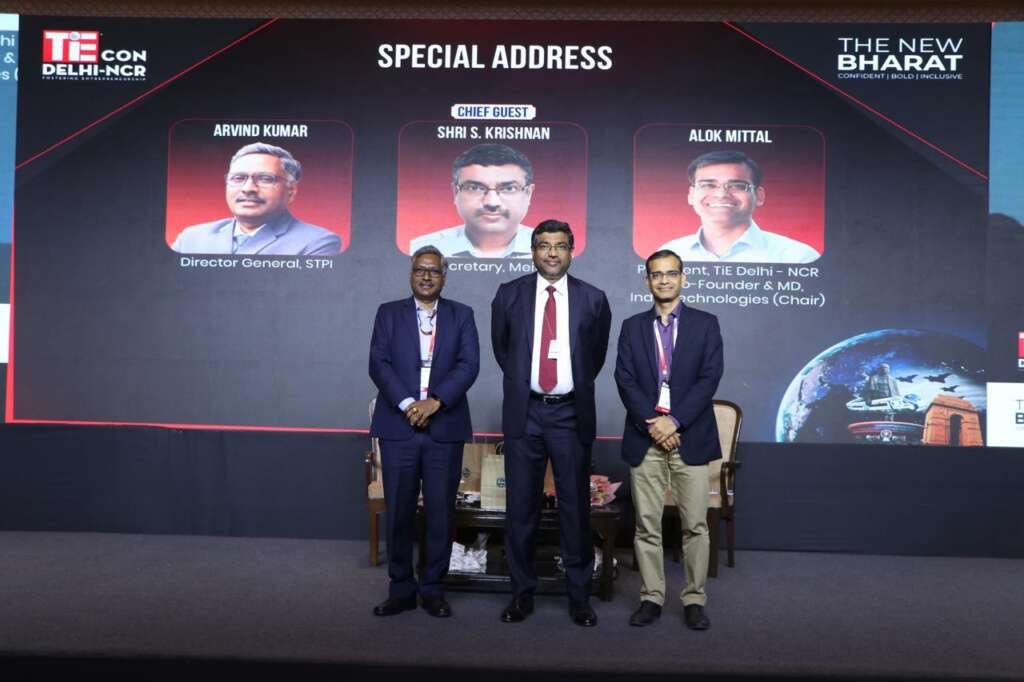
India Plans 10,000 AI Graphics Processing Units (GPUs) as Part of IndiaAI Mission
TiEcon Delhi buzzed with startups as a pivotal AI announcement shaped India’s future.
NEW DELHI, India (AI Reporter/News): India is planning to roll out 10,000 AI graphics processing units (GPUs) as part of a robust Rs 10,372 crore (USD 1.372 billion) IndiaAI Mission in the next 2 years.
S Krishnan, the Secretary of the Ministry of Electronics and Information Technology (MeitY), Govt. of India at TiEcon Delhi 2024 stepped forward with a declaration that promises to redefine the landscape of AI development in the country.
The Indian government, in a visionary move, plans to roll out AI graphics processing units (GPUs) as part of a robust Rs 10,372 crore (USD 1.372 Billion) IndiaAI Mission slated for realization in the coming 18-24 months, S Krishnan said while addressing the TiEcon Delhi 2024, a flagship startup event by TiE Delhi-NCR on March 10, 2024 in New Delhi.
The IndiaAI Compute Capacity is a crucial element of the government’s plan to boost AI innovation in India under the IndiaAI Mission launched on March 7, 2024. It aims to build a powerful and adaptable AI computing infrastructure by installing over 10,000 GPUs. This will be achieved through partnerships between the public and private sectors.
Highlighting the growing importance of AI, Artificial Intelligence Took Center Stage at TiEcon Delhi 2024.
Imagine a part in your computer specifically for visuals. That’s the GPU! It helps display graphics, effects, and videos smoothly.
There are two main types: Built-in GPU: This is like a small helper inside your computer, good for basic tasks like watching videos or light gaming.
Separate GPU: Think of this as a super-powered graphics card you can add to your computer. It’s great for demanding tasks like video editing or intense gaming.
The government’s target is that AI graphics processing units (GPUs) under the government’s Rs 10,372 crore AI Mission will be available in the next 18-24 months. Aligned with the broader vision of the India AI Mission.
– S Krishnan, Secretary, MeitY, said at TiEcon Delhi 2024
By equipping India’s bright minds with state-of-the-art AI capabilities, the IndiaAI Mission aims to unleash a new wave of creativity, problem-solving, and entrepreneurial spirit across various sectors.
Setting the Stage for Ethical AI
In his address, Krishnan highlighted the mission’s commitment to ethical and responsible AI deployment. This aspect is crucial as it ensures that India’s advancements in AI technology are aligned with global standards and best practices, promoting safe, secure, and ethical AI applications.
In a remarkable gathering at TiEcon Delhi 2024, key figures from the Indian startup ecosystem congregated to outline the future of technology and entrepreneurship in India. With over 2000 delegates, 100 speakers, and 50 investors in attendance, the conference, themed ‘The New Bharat: Confident I Bold I Inclusion,’ celebrated the indomitable spirit of innovation.
Aligned with the broader vision of the India AI Mission, these initiatives aim to bolster India’s global leadership, foster technological self-reliance, ensure ethical and responsible AI deployment, and democratize the benefits of AI across all strata of society.
S Krishnan, Secretary, MeitY, said at TiEcon Delhi 2024

Vision for a Data-Driven Future
Vishal Dhupar, MD Asia South at NVIDIA, presented a compelling vision for India’s future as a leader in data and AI. He advocated for building “intelligence” within India for export, transforming the nation from the “Back Office of the World” to the “Office of the World.”
Highlighting India’s vast pool of software engineers, Dhupar emphasized the need for the country to develop its own AI models and leverage its data center capacity to become a global leader in accelerated computing.

Let’s build the Intelligence in India and Export it. It will transform India from the Back Office of the world to ‘the Office’ of the World. India is a country of software engineers, and it is the time now for the country to start building its own AI models.
Vishal Dhupar, MD Asia South, NVIDIA
“The global data center industry is around USD 4 trillion which is going to double, and India has close to about 1-2 percent of the total global capacity. And we are going to take this whole world’s software into accelerated computing.”, Dhupar added.
…India has close to about 1-2 percent of the total global capacity.
Vishal Dhupar, MD Asia South, NVIDIA

Deep Kalra, Founder of MakeMyTrip said, “The biggest driver for an entrepreneur is belief. Belief in our business. If you don’t have funding or are going through tough times, it is your belief that carries you through. Resilience is key in navigating the ever-evolving landscape shaped by emerging technologies such as AI.”
Fund of Funds Fuels Startup Growth
Further bolstering the startup ecosystem, Sivasubramanian Ramann, Chairman of SIDBI, highlighted the role of the Fund of Funds for Start-ups (FFS). He revealed that the FFS has committed Rs 9,500 crore to promote new ventures, leveraging this investment to attract over Rs 56,000 crore from more than 100 Alternative Investment Funds (AIFs). This initiative aligns with the Start-up India Action Plan, providing crucial financial support for the growth and development of innovative startups.
Focus on Women Entrepreneurs
Ramann emphasized the need to recognize and empower women entrepreneurs. He acknowledged the declining participation rate of women in the workforce across various states and stressed the importance of encouraging women to become active contributors to the economy.
Collective Effort Drives Success
TiEcon Delhi 2024 was supported by acclaimed business and industry partners such as Startup India, Maruti Suzuki Innovation, Havas India, SAP, AWS, PeakXV, Microsoft, STPI, NETAPP Excellerator, and many more, reflecting the collaborative spirit driving India’s startup ecosystem forward.
***

What is Graphics Processing Technology (GPT)?
GPU is a specialized chip designed for handling graphics and video processing efficiently.
GPU stands for Graphics Processing Unit. Graphics Processing Technology (GPT) signifies the hardware and software innovations that enable computers to create, manipulate, and display images, videos, and animations. This technology is pivotal in transforming data into visual content on screens. It encompasses various processes, including rendering, shading, and texture mapping.
As GPUs have parallel processing power, they have become highly effective in accelerating various tasks beyond graphics, including Artificial Intelligence (AI).
Graphics Processing Technology has become integral to video games, film production, and virtual reality applications. Its advancements lead to more realistic and immersive digital experiences. At the heart of GPT are Graphics Processing Units (GPUs), specialized hardware designed for efficient image and video processing.
GPUs manage complex calculations faster than traditional CPUs, especially for parallel tasks. This efficiency makes GPT essential not just in graphics creation but in scientific computing and machine learning too. As GPT evolves, it continues to open new frontiers in digital interaction and visualization.
***
What is a Graphics Processing Unit (GPU)?
GPUs are superstars in gaming. It is also helpful for video editing, making special effects in movies, and even creating artificial intelligence (AI)!
Imagine your computer as a bustling metropolis, each component playing a unique role in shaping its skyline. Among these architectural marvels stands the Graphics Processing Unit (GPU), the city’s artistic virtuoso.
With lightning-fast precision, the GPU transforms mere data into vibrant visual landscapes, breathing life into digital realms with every pixel it touches. But its talents extend far beyond rendering breathtaking graphics for games and movies.
In the realm of artificial intelligence (AI) and scientific exploration, the GPU emerges as a silent powerhouse, crunching numbers and unraveling complex algorithms with unparalleled speed. Its parallel processing prowess unlocks new frontiers in deep learning, data analysis, and simulation, propelling humanity towards groundbreaking discoveries.
In the age of digital innovation, the GPU stands as a beacon of creativity and efficiency, fueling our imagination and driving progress forward with each flicker of light on the screen. It’s not just a component; it’s the architect of our technological dreams, shaping the world one pixel at a time. Read More.
***
Graphics Processing Units and AI
GPUs are great for AI. GPUs can handle complex calculations much faster than CPUs. This is due to their parallel processing architecture and features specifically designed for AI workloads. GPUs have been essential for the recent advancements in AI. The performance of GPUs keeps improving. With the help of powerful GPUs and software tools, researchers and developers are creating new and innovative AI applications across various industries.
(copyright@aireporter.news)

